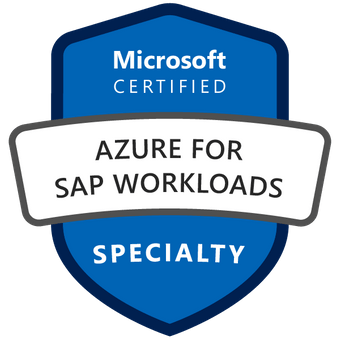
Course Description
This course teaches IT Professionals experienced in SAP solutions how to leverage Azure resources that include deployment and configuration of virtual machines, virtual networks, storage accounts, and Azure AD that includes implementing and managing hybrid identities. Students of this course will learn through concepts, scenarios, procedures, and hands-on labs how to best plan and implement migration and operation of an SAP solution on Azure. Your will receive guidance on subscriptions, create and scale virtual machines, implement storage solutions, configure virtual networking, back up and share data, connect Azure and on-premises sites, manage network traffic, implement Azure Active Directory, secure identities, and monitor your solution.
Who Should Attend?
This course is for Azure Administrators who migrate and manage SAP solutions on Azure. Azure Administrators manage the cloud services that span storage, networking, and compute cloud capabilities, with a deep understanding of each service across the full IT lifecycle. They take end-user requests for new cloud applications and make recommendations on services to use for optimal performance and scale, as well as provision, size, monitor and adjust as appropriate. This role requires communicating and coordinating with vendors. Azure Administrators use the Azure Portal and as they become more proficient they use PowerShell and the Command Line Interface.
About this course
Course Outline
-
Migrate SAP workloads to Azure (25–30%)
-
Design and implement an infrastructure to support SAP workloads on Azure (25–30%)
-
Design and implement high availability and disaster recovery (HA/DR) (20–25%)
-
Maintain SAP workloads on Azure (15–20%)
-
Estimate target sizing for SAP workloads
-
Determine supportability of SAP workloads in Azure
-
Evaluate compliance by using SAP HANA hardware and cloud measurement tools
-
Identify compute, storage, and network requirements for SAP workloads
-
Assess constraints imposed by subscription models and quota limits
-
Evaluate licensing and pricing across SAP tiers
-
Identify an appropriate data integration service
-
Specify an Azure support plan for target infrastructure
-
Design and implement access control for SAP workloads
-
Design and implement governance and compliance by using Azure Policy
-
Design and integrate Microsoft Azure Active Directory (Azure AD), part of Microsoft Entra, Azure Active Directory Domain Services (Azure AD DS), and Active Directory authentication for SAP workloads
-
Design and implement authentication for SAP software as a service–based (SaaS-based) applications
-
Choose between lift-and-shift, lift-shift-migrate, and lift-shift-migrate to HANA
-
Choose an appropriate SAP workload migration strategy and tools
-
Design and implement an SAP migration to Azure
-
Configure storage to support migration
-
Specify an appropriate compute platform, including Azure Virtual Machines
-
Choose an SAP-certified Azure virtual machine for a given SAP workload
-
Configure the Azure VM extension for SAP solutions
-
Deploy an operating system by using an Azure Marketplace image
-
Create and deploy a custom image to an Azure virtual machine
-
Automate deployment of Azure Virtual Machines by using infrastructure as code
-
Design and implement virtual networks and subnets
-
Implement Accelerated Networking for Azure Virtual Machines
-
Design and configure proximity placement groups
-
Design networking to minimize latency
-
Design and implement network security
-
Design and implement service endpoints and private endpoints for Azure Storage
-
Design and implement network flow control
-
Design name resolution for integration with Azure DNS
-
Design and configure Azure ExpressRoute for hybrid connectivity
-
Design and configure load balancing for a reverse proxy
-
Specify an appropriate storage option, including Managed, Premium, Ultra disk, SOFS with Storage Spaces Direct, Azure NetApp Files, and Azure shared disks
-
Specify when to use disk striping and simple volumes
-
Design for storage security considerations
-
Design and implement data protection
-
Design and implement caching for disks
-
Configure Write Accelerator
-
Configure encryption for storage, disks, and data
-
Design for service-level agreement (SLA) considerations
-
Design and deploy SAP workloads into availability sets and availability zones
-
Design and implement load balancing for high availability
-
Configure clustering for SAP HANA and SAP Central Services
-
Configure Pacemaker and STONITH
-
Configure an Azure fence agent or STONITH Block Device (SBD)
-
Design and configure storage-level replication for SAP workloads
-
Automate deployment by using the SAP deployment automation framework on Azure
-
Design and implement an Azure Site Recovery strategy for SAP infrastructure
-
Design a disaster recovery solution with regional considerations
-
Specify network configurations for disaster recovery
-
Design and implement policies for backups and snapshots
-
Configure and validate snapshots and backups for SAP workloads
-
Perform backup and restore
-
Test disaster recovery
-
Optimize performance and costs for an SAP workload by using Azure Advisor recommendations
-
Analyze and optimize network performance
-
Optimize costs by configuring snoozing and deploying virtual machines (VMs) to reserved instances
-
Optimize performance and cost by resizing VMs
-
Optimize storage costs
-
Optimize performance and cost of SAP application servers and databases
-
Monitor VMs
-
Monitor high availability
-
Monitor storage
-
Monitor networking
-
Configure Azure Monitor for SAP Solutions
Prerequisites
Before attending this course, students should have:
-
Hands-on experience with Azure IaaS and PaaS solutions, including VM, VNet, Load Balancers, Storage (Blob, Files, Disks).
-
Understanding of on-premises and cloud virtualization technologies, including: VMs, virtual networking, and virtual hard disks.
-
Understanding of network configuration, including TCP/IP, Domain Name System (DNS), virtual private networks (VPNs), firewalls, and encryption technologies.
-
Understanding of Active Directory concepts
-
Experience with Linux/Unix environments.
-
Solid knowledge of SAP Applications, SAP HANA, S/4HANA, SAP NetWeaver, SAP BW, OS Servers for SAP Applications and Databases.
-
Understanding of SAP HANA deployment and configuration.
-
Hands-on experience with SAP HANA administration.
Prerequisite Courses (or equivalent knowledge and hands-on experience):
- AZ-104 Azure Administrator
- Knowledge of SAP products such as SAP HANA or SAP NetWeaver
Where
This will be a virtual event hosted on Microsoft Teams. In the Microsoft Teams platform and sessions, your name, email address, or title may be viewable by other participants. By joining this event, you agree to this experience.
